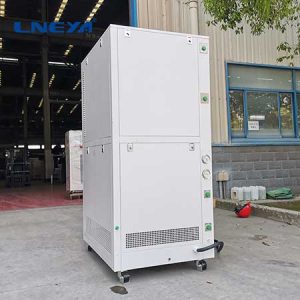What should be paid attention to in the maintenance of the chiller for laboratory?
(1) Check the overall appearance of the FL +5°C ~ +35°C Kaltwassersätze in the laboratory and whether the fins are deformed;
(2) Check whether there is too much frost on the fins of the cooler in the laboratory. If there is too much frost, increase the hot water temperature (water bath type) or adopt intermittent working mode;

(3) Check whether the welded junction of the pipe system between the laboratory cooler and the vaporizer has cracks and leaks;
(4) Check whether the switching (automatic) devices of each group are normal;
(5) Check whether the relevant safety accessories of the laboratory cooler are in good condition;
(6) Check whether the foundation of the laboratory cooler equipment is firm.
1. What should be paid attention to when disassembling the cooler in the laboratory?

Before disassembling the plate cooler, the inlet and outlet oil and water valves should be closed to discharge the trapped medium before disassembling.
When disassembling, remove the water return and water distribution covers of the plate cooler first, and carefully check whether the sealing ring and plate cooler tube are damaged or have scale.
If too much dirt blocks the plate cooling organ, it should be dredged immediately or replaced with a new one; If the tube bundle of the plate cooler must be pulled out, it should be moved out from the direction of the fixed tube sheet first.
The large plate cooler can use the fixed tube sheet downward, and finally use the lifting device to lift the shell, so that the tube bundle will be exposed and can be pulled out.

After disassembly, it needs to be installed. Before assembly, the sealing rings can be replaced with new ones. The assembly method is the reverse process of disassembly. After installation, the oil test must be carried out first, and then the air tightness test at the water side. The test pressure should be 1.2 times greater than the actual working pressure.
2. What are the characteristics of the laboratory cooler?
(1) The cooler in the laboratory adopts bare tube (no rolled fins on the surface) heat transfer tube, which has high heat transfer coefficient and strong anti pollution ability.
(2) The spiral deflector of the laboratory cooler makes the cooled liquid continuously and evenly roll in a spiral shape, overcoming the heat and cold exchange efficiency generated by the deflector.
(3) The cooler in the laboratory is sealed with expanded pipe, which overcomes the adverse change of materials after high temperature welding.
(4) The laboratory cooler has good structural performance, stable sealing performance, high heat transfer efficiency and compact structure.
 LNEYA
LNEYA
 简体中文
简体中文


















































































